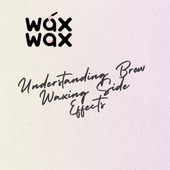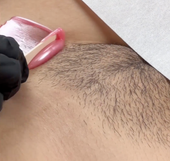Ibuprofen Before Waxing: A Pro's Guide to Pain Management
Compartir
TL;DR: The Pro Guide to Ibuprofen for Waxing
Here’s the quick, responsible guide for our busy WaxFam:
- Does it work? Yes, for many people. As an anti-inflammatory, it can help reduce both the pain of the pull and the redness afterward.
- What is it? Ibuprofen (like Advil) is an NSAID (nonsteroidal anti-inflammatory drug) that works by blocking the body's pain and inflammation signals.
- When to take it? 30-45 minutes before your appointment, with a small snack or milk.
- Is it a magic bullet? No. It's just one part of a 5-step strategy. The #1 way to reduce pain is to use a high-quality hard wax.
- The Disclaimer: We are skin experts, not doctors. Always follow the directions on the bottle and consult your physician if you have any questions or health conditions.
Hello WaxFam! Let's Talk About Pre-Wax Pain Relief
Hey, WaxFam. Let's talk about the #1 barrier for new waxers: the fear of pain. We've all heard the "tips and tricks," and the most common one is to "pop an ibuprofen" before you start.
But does it actually work? And is it safe?
As the #1 specialist in hard wax for sensitive skin, we at Wax Wax believe in a 360-degree approach to a comfortable wax. A flawless result starts with our Made in Italy hard wax formula, which is designed to be gentle, but it also includes proper prep.
This is your official, pro-level guide to using ibuprofen for waxing. We'll cover the science, the timing, and how to fit it into a complete pain management strategy. We are not doctors, so we will not give medical advice, but we are estheticians, and we can give you the professional-grade information you need.
What is Ibuprofen and How Does It Work?
First, let's understand the tool. Ibuprofen (brand names: Advil, Motrin) is what's known as an NSAID (nonsteroidal anti-inflammatory drug).
It works by blocking your body's production of "prostaglandins." These are chemicals your body releases when there's an injury (like a hair being pulled from the root!). Prostaglandins are what signal your brain that you're in pain and what cause the area to get red and swollen.
By taking ibuprofen before you wax, you're getting ahead of the problem. You're reducing the number of these "alarm bells" in your system, which can make the whole experience much more comfortable. For a full medical breakdown of its uses and side effects, you can read the guide from MedlinePlus, which is an excellent, unbiased resource.
Why Use It for Waxing? The 2-Fold Benefit
Using ibuprofen for waxing isn't just about pain. It's a 2-in-1 strategy.
- It's an Analgesic (Pain Reliever): This is the one you know. It helps dull the "ouch" of the pull itself.
- It's an Anti-Inflammatory (Redness Reducer): This is the one most people forget. Because it blocks those inflammation signals, it can dramatically reduce the immediate redness, swelling, and "hot" feeling you get after a body wax.
For a complete list of all the ways to make waxing more comfortable, check out our full guide on how to make waxing less painful.
How to Safely Use Ibuprofen Before Your Session
If you've checked with your doctor and decided ibuprofen is a good choice for you, timing is everything.
- When: Take it 30 to 45 minutes before your appointment or at-home session. This gives it time to get into your system and be fully effective before the first pull.
- Dosage: We cannot and will not tell you what dose to take. You must always follow the instructions on the bottle for a standard over-the-counter dose.
- With Food: Don't take it on an empty stomach, as it can cause irritation. Have a small snack, like a piece of toast or a glass of milk, with it.
The Pro-Pain Management Checklist
Ibuprofen is just one step in a 5-step pro-level plan. Here is the full checklist for a truly less-painful wax.
| Step | Pro-Pain Reduction Strategy |
|---|---|
| Step 1: Choose Your Wax | This is the #1 factor. Use a high-quality **hard wax**. It sticks *only* to the hair, not your skin, which is why hard wax is less painful compared to soft wax . |
| Step 2: Prep Your Skin | Exfoliate 24-48 hours before. This clears dead skin so the wax grabs the hair on the first pull. See our pre-wax prep guide. |
| Step 3: Check Your Cycle | Don't wax the week before or during your period. Your skin is most sensitive. The best time is the week *after* your period. |
| Step 4: Consider an NSAID | If you're cleared by your doctor, take an ibuprofen 30-45 minutes before your session to reduce pain and inflammation. |
| Step 5: Use Pro Technique | Hold the skin **TAUT** with your free hand. This anchors the skin and isolates the hair, making the pull feel clean, not sharp. |
What This Means for You
For our WaxFam (At-Home Users): If you're getting ready for a session with your home waxing kit, following this 5-step plan is the best way to ensure a comfortable, positive experience. A low-pain wax will give you the confidence to stay consistent!
For our WaxFam Pro (Estheticians & Salon Owners): You cannot (and should not) ever provide medication to your clients. However, you can be an educated resource. When a nervous client asks about pain, you can say: "The best way to reduce pain is to use a high-quality hypoallergenic hard wax like the one I use. Also, some clients find that taking an over-the-counter anti-inflammatory, like ibuprofen, 30 minutes before they arrive can help. Of course, they should check with their doctor first." This builds massive trust and authority. (And make sure you're always stocked with the best bulk hard wax for estheticians).
Frequently Asked Questions
What's the difference between Ibuprofen (Advil) and Acetaminophen (Tylenol) for waxing?
This is a great question. Tylenol is an analgesic (pain reliever) but it is not an anti-inflammatory. Ibuprofen is both. For waxing, ibuprofen is generally preferred because it helps with both the pain of the pull and the swelling/redness after.
Can I take ibuprofen after waxing?
Yes. If you didn't take it before and you're feeling sore or seeing a lot of inflammation, taking an ibuprofen after your service can help calm that swelling and redness from the inside out. Pair it with a topical soothing lotion like our Blue Silk After-Wax Lotion.
What about Aspirin?
Most pros recommend you avoid aspirin. Aspirin is a blood thinner, which can, in some cases, increase the risk of "pinpoint bleeding" (the tiny specks of blood you sometimes see after a pull).
Will ibuprofen make me bleed more?
Unlike aspirin, ibuprofen's effect on blood thinning is very minimal and temporary. For most people, it's not a concern. Aspirin is the one to avoid.
I have very sensitive skin. Is it safe?
Ibuprofen itself doesn't affect your skin's surface. The best thing you can do for sensitive skin is to use a wax designed for it. Our formulas are hypoallergenic, and you can read about the science of our sensitive skin ingredients for this exact reason.
What's more effective: ibuprofen or numbing cream?
We recommend ibuprofen over numbing cream. Numbing creams can interfere with the wax's grip by leaving a film on the skin, and they don't do anything to stop the inflammation that happens after the pull.
Our Final Word: A Smart Wax is a Less Painful Wax
So, WaxFam, the answer is yes, ibuprofen can be an effective tool in your pain-reduction kit.
But it's not a magic bullet. The real secret to a less painful wax is a holistic approach: use a superior product (hard wax!), respect your body's timing, and use proper, professional techniques. The ibuprofen is just the final, optional "cherry on top" to ensure the most comfortable experience possible.
Related Posts
-

How to Properly Position Clients for Waxing: The Pro-Esthetician's Guide
TL;DR: For the Busy WaxFam Pro Here’s the high-level summary of professional positioning: It's Not Just Comfort, It...
-

What Is the Best Lotion for Preventing Ingrown Hairs? A Pro's Guide
TL;DR: The Pro-Grade Solution Here’s what to look for when you're shopping for the "best" lotion: It's a "Treatment...
-

Infected Ingrown Hair vs. Pimple: How to Tell the Difference
TL;DR: What Your Bump Is Telling You Here’s the fast guide to identifying that mysterious red bump: Is it a Pimple?...
-

How to Remove a Deep, Painful Ingrown Hair (Safely)
TL;DR: What to Do About a Deep Ingrown Hair Here's the short, safe answer for our WaxFam: STOP! Put the Tweezers Do...
-

How to Exfoliate to Prevent Ingrown Hairs (The Pro Guide)
TL;DR: The Pro-Exfoliation Method Here's the quick guide to stopping ingrown hairs before they start: Why Exfoliate...
-

Are Dyes in Hard Wax Safe? A Guide to Hypoallergenic Formulas
TL;DR: Are Dyes in Wax Safe? Here’s the short answer for our busy WaxFam: Not all dyes are bad, but low-quality, har...
-

The Real Secret to Waxing Salon Client Retention
TL;DR Client retention isn't just marketing; it's built into the core of your waxing service, starting with the pr...
-

The Ultimate Guide to Waxing Techniques
TL;DR Mastering waxing techniques means understanding more than just pulling hair. It’s about a holistic process: ch...
-

Guía de solución de problemas para esteticistas: Cómo solucionar las 5 reacciones cutáneas más comunes después de la depilación
TL;DR / Resumen ejecutivo Las reacciones cutáneas posteriores a la depilación pueden minar la confianza del cl...
-

Cómo realizar ventas adicionales y cruzadas de productos minoristas de manera eficaz en su salón
TL;DR / Resumen ejecutivo La venta adicional y cruzada de productos minoristas en su salón de depilación puede...
-

Los más altos estándares de higiene y saneamiento para un salón de depilación
TL;DR / Resumen ejecutivo Mantener los más altos estándares de higiene y saneamiento es fundamental para los s...
-

La ciencia de la sensibilidad: un análisis profundo de los ingredientes hipoalergénicos de las ceras duras WaxWax.com
TL;DR / Resumen ejecutivo La seguridad y la satisfacción del cliente son primordiales en un salón de depilació...
-

Procedimientos operativos estándar obligatorios (POE) para un salón de depilación moderno
TL;DR / Resumen ejecutivo Implementar Procedimientos Operativos Estándar (POE) sólidos es esencial para que un...
-

Consideraciones clave en un contrato de franquicia y documento de divulgación
TL;DR / Resumen ejecutivo Abrir una franquicia de depilación y comenzar un negocio de depilación requiere un p...
-

Cómo aprovechar las redes sociales (Instagram, TikTok) para tu salón de depilación
TL;DR / Resumen ejecutivo Las plataformas de redes sociales como Instagram y TikTok son herramientas poderosas...
-

Consejos para reclutar, capacitar y retener a esteticistas profesionales
TL;DR / Resumen ejecutivo Reclutar, capacitar y retener a esteticistas profesionales es fundamental para el éx...
-

Guía de permisos y licencias comerciales necesarios para abrir un salón
Resumen Abrir una franquicia de salón de depilación y depilación requiere gestionar una compleja red de permis...
-

Análisis del potencial de ganancias y el ROI de una franquicia de belleza
TL;DR / Resumen ejecutivo Invertir en una franquicia de salón de belleza ofrece un potencial de ganancias cons...
-

Las 10 preguntas más frecuentes sobre franquicias de depilación con cera
TL;DR / Resumen ejecutivo Explorar una oportunidad de franquicia de depilación puede ser un cambio radical para ...
-

Los 5 principales desafíos que enfrentan las empresas de depilación y cómo las franquicias pueden ser la solución
TL;DR / Resumen ejecutivo Los negocios de depilación enfrentan desafíos importantes que pueden obstaculizar la r...
-

Guía paso a paso para elegir una ubicación estratégica para un salón de depilación
TL;DR / Resumen ejecutivo Seleccionar la ubicación perfecta para su salón de depilación es una decisión fundamen...
-

Franquicia vs. Salón de depilación independiente: Análisis de ventajas y desventajas
TL;DR / Resumen ejecutivo Decidir entre una franquicia o un salón de depilación independiente es una decisión cr...
-

Un desglose completo de los costos iniciales para abrir un salón de depilación
TL;DR / Resumen ejecutivo Abrir un salón de depilación requiere una planificación financiera cuidadosa para gara...
-

Guía completa para franquiciados de depilación con cera (2025)
TL;DR / Resumen ejecutivo Iniciar una franquicia de depilación en 2025 exige un enfoque estratégico para garanti...
-

Beneficios del té de caléndula para la piel al depilarse: Tu guía de WaxFam para una piel suave y aliviada
Hola WaxFam, ¡vamos a calmar vuestra piel con caléndula! ¡Hola, WaxFam! ¿Lista para mejorar tu depilación con un...
-

Rutina de cuidado de la piel para un escote juvenil de Wax Wax
Hola WaxFam, ¡vamos a darle brillo a tu escote! ¡Hola, WaxFam! ¿Lista para darle a tu escote el tratamiento estr...
-

Cómo elegir la mejor cera dura para depilar las cejas
Hola WaxFam, ¡vamos a esculpir esas cejas correctamente! ¿Qué tal, WaxFam? ¿Lista para realzar tus cejas con arc...
-

Preparación para la depilación de cejas: consejos para una experiencia impecable
Hola WaxFam, ¡prepárate para unas cejas perfectas! ¿Qué tal, WaxFam? ¿Lista para esculpir tus cejas y lograr arc...
-

Cuidados posteriores a la depilación de cejas: Cómo suavizar y mantener unas cejas perfectas
Hola WaxFam, ¡mantengamos esas cejas impecables! ¡Hola, WaxFam! ¿Te acabas de depilar las cejas y te sientes incre...
-

Errores comunes al depilarse las cejas (y cómo evitarlos con cera dura)
Hola WaxFam, ¡vamos a conseguir esas cejas perfectas! ¡Bienvenidos, WaxFam, a tu guía para una depilación...
-

¿Puedes ducharte después de la depilación? Guía WaxFam para el cuidado post-depilación
¿Qué tal, WaxFam? ¿Recién depilada y con una sensación fabulosa? En Wax Wax, nos dedicamos a ofrecerte la piel más ...
-

¿Puedes depilarte durante la regla? Guía WaxFam para una confianza plena
¡Hola, WaxFam! Ya sea que te estés preparando para un día de playa o simplemente quieras tener una piel suave, Wax ...
-

¿La depilación con cera ralentiza el crecimiento del vello? La verdad revelada para WaxFam
¡Bienvenidos, WaxFam, a otra inmersión profunda en el mundo de la piel suave y radiante! En Wax Wax, nos dedicamos ...
-

Depilación de cejas para hombres: Cómo abordar los efectos secundarios con las soluciones de cera dura de WaxWax
Hola WaxFam, ¡hablemos de depilación de cejas para hombres! Bienvenido a la familia WaxWax, donde nos dedicamos ...
-

¿Infecciones después de la depilación? Aquí te explicamos cómo prevenirlas y tratarlas naturalmente con WaxWax.
¡Hola, WaxFam! Hablemos de las infecciones después de la depilación (y cómo evitarlas) Lo entendemos, WaxFam: la...
-

Cambios en la pigmentación después de la depilación: causas, soluciones y cómo WaxWax puede salvar tu piel.
Hola WaxFam, ¡brillemos sin problemas de pigmentación! ¿Qué tal, WaxFam? ¿Lista para lucir un brillo suave y sin...
-

Daños graves en la piel después de la depilación: efectos secundarios, soluciones y cómo la cera puede salvar el día.
Hola WaxFam, ¡hablemos de los problemas y los éxitos de la depilación! ¡Bienvenido al ambiente WaxWax, donde una...
-

Reacciones alérgicas e inmunitarias a la depilación con cera: Tu guía para una piel suave y segura con WaxWax
Hola WaxFam, ¡dile adiós a los problemas de depilación con WaxWax! ¡Bienvenido al ambiente WaxWax, donde la piel...
-

Foliculitis después de la depilación: causas, prevención y tratamiento para una piel suave y radiante
WaxFam, lo entendemos: nada supera los resultados sedosos y duraderos de una depilación fresca. ¿Pero esos molestos...
-

Guía para WaxFam sobre la normativa de cera dura en Canadá: 2025
¡Hola WaxFam! Tanto si eres un esteticista profesional que domina la depilación con cera para sus clientes como si ...
-

Cera dura para piel sensible: las mejores opciones recomendadas por dermatólogos canadienses
¡Hola, WaxFam! La piel sensible puede ser una batalla en el clima extremo de Canadá, donde los inviernos gélidos y ...
-

Cera dura ecológica en Canadá: belleza sostenible para consumidores conscientes
¡Hola WaxFam! Los canadienses están a la vanguardia de la belleza ecológica, y la cera dura vegana y ecológica está...
-

La guía definitiva para canadienses sobre depilación durante todo el año: datos, consejos y estrategias según la temporada
¡Hola WaxFam! Una piel suave no es solo para el verano: la depilación con cera durante todo el año te mantiene radi...
-

Depilación en invierno en Canadá: Las mejores opciones de cera dura para pieles secas y sensibles
¡Hola WaxFam! Los inviernos canadienses son implacables: vientos gélidos, temperaturas bajo cero y el calor seco en...
-

Estilos de depilación femenina: tendencias, datos y perspectivas
¡Hola WaxFam! ¡Bienvenidas a tu guía definitiva sobre estilos de depilación para mujeres! La depilación con cera es...
-

Qué no hacer antes de una depilación brasileña
¡Hola, WaxFam! Les damos la bienvenida a otra inmersión profunda en el mundo de la depilación suave, segura y sin p...
-

¿Por qué la depilación brasileña se llama brasileña?
¡Hola, WaxFam! Les damos la bienvenida a otra exploración a fondo de Wax Wax, su marca de referencia para todo lo r...
-

Cuidados después de la depilación: consejos esenciales para una piel suave y radiante
¡Hola WaxFam! Tanto si eres una usuaria que domina la depilación en casa como si eres una esteticista profesion...
-

Cera Hollywood: tu guía completa para un acabado sedoso
¡Hola, WaxFam! Bienvenidos de nuevo a otro blog repleto de información de Wax Wax, la marca dedicada a ayudarte a c...


















































